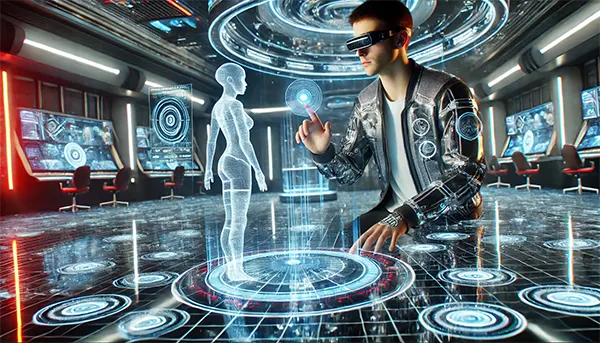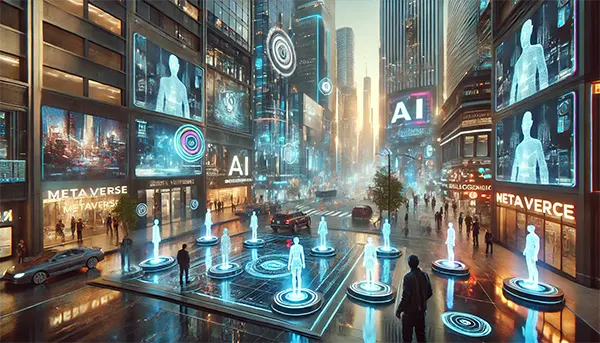
Hyperrealistic Metaverse: How Artificial Intelligence Shapes the New Virtual Reality
Imagine a world where virtual reality is so realistic that it becomes indistinguishable from the physical realm. This is no longer a distant sci-fi concept but an emerging reality, thanks to advancements in artificial intelligence (AI). As AI continues to evolve, it is revolutionising the metaverse, creating hyperrealistic virtual environments that enhance immersion, interaction, and digital experiences.
The Role of AI in the Evolution of the Metaverse
Artificial intelligence plays a crucial role in shaping the next-generation metaverse by enhancing the realism, interactivity, and efficiency of digital spaces. AI-powered algorithms contribute to world-building, character development, and seamless interactions, making virtual environments more dynamic and engaging.
One of AI’s primary contributions is procedural generation, which allows for the creation of vast, detailed, and ever-changing landscapes. This technique enables metaverse platforms to generate environments in real time, reducing the need for manual design while maintaining a high level of detail.
AI-driven NPCs (non-player characters) also add depth to virtual worlds by mimicking human behaviour. Unlike traditional scripted interactions, these AI entities learn and adapt, offering personalised experiences based on user engagement and preferences.
Machine Learning and Realistic Avatars
Machine learning algorithms have made it possible to create hyperrealistic avatars that accurately capture human expressions, emotions, and body movements. Through facial recognition technology and neural networks, AI enables users to embody digital representations that reflect their physical and emotional states.
Real-time motion capture further enhances user immersion, allowing avatars to move naturally and react intuitively to virtual surroundings. This level of realism creates a more authentic social experience, bridging the gap between physical and digital interactions.
Additionally, AI-powered voice synthesis and natural language processing (NLP) improve avatar communication, making conversations in the metaverse feel more fluid and lifelike. These advancements pave the way for deeper engagement in virtual communities, fostering meaningful connections across digital landscapes.
AI and Hyperrealistic Environments
The integration of AI in the metaverse extends beyond avatars to the very environments users explore. AI-driven rendering techniques enhance graphical fidelity, producing lifelike textures, lighting effects, and environmental physics that replicate real-world conditions.
One of the most significant breakthroughs is AI-enhanced ray tracing, which simulates the behaviour of light in digital spaces. This technology enables realistic reflections, shadows, and depth perception, making virtual worlds feel tangible and immersive.
AI is also instrumental in spatial computing, ensuring that objects and avatars interact realistically within the metaverse. From simulating gravity to rendering fluid dynamics, AI-driven physics engines create environments that respond naturally to user actions.
Personalised Experiences and Adaptive AI
AI’s ability to analyse user behaviour and preferences enables personalised metaverse experiences. Adaptive AI systems adjust virtual environments, tailoring content, recommendations, and activities to individual users.
For instance, AI can curate dynamic storylines and quests based on user choices, creating unique experiences that evolve over time. This level of personalisation fosters deeper engagement, making the metaverse a space that continuously adapts to user interests.
Furthermore, AI-driven moderation ensures a safe and inclusive digital environment by detecting and preventing harmful behaviour. Through automated content monitoring and real-time analysis, AI helps maintain ethical standards within virtual communities.

The Future of AI in the Metaverse
As AI technology advances, the metaverse will continue to evolve into a hyperrealistic and interactive digital ecosystem. Innovations in deep learning, neural networks, and augmented reality will further blur the lines between the physical and virtual worlds.
One of the most anticipated developments is the integration of brain-computer interfaces (BCIs), which could enable direct neural interaction with the metaverse. This technology has the potential to redefine digital communication, allowing users to control avatars and interact with virtual environments using only their thoughts.
Moreover, AI-driven automation will enhance the efficiency of virtual economies, streamlining transactions, asset creation, and decentralised governance. These advancements will shape the metaverse into a sustainable and self-regulating digital society.
Ethical Considerations and Challenges
Despite its potential, the AI-powered metaverse presents ethical challenges that must be addressed. Issues such as data privacy, digital identity security, and AI bias require careful regulation to ensure fair and transparent digital experiences.
As AI continues to shape the metaverse, it is essential to establish ethical guidelines that prioritise user rights and safety. Collaboration between technology developers, policymakers, and the global community will be crucial in building a metaverse that is not only immersive but also ethical and inclusive.
With AI at the forefront of metaverse development, the future of digital interaction promises to be more lifelike, engaging, and transformative than ever before.





